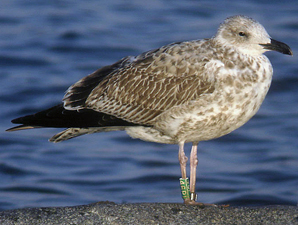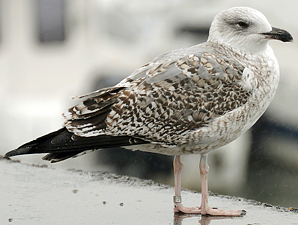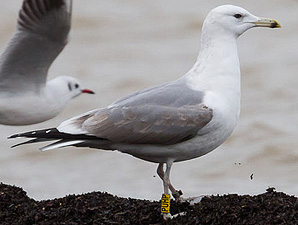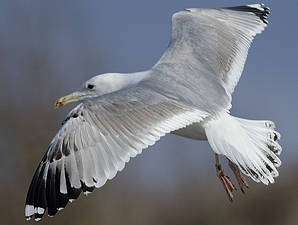 Larus cachinnans
Larus cachinnans
(last update:
Greg Neubauer
Marcin Przymencki
Albert de Jong
Mars Muusse
 sub-adult cachinnans: October
sub-adult cachinnans: October
In 2011, Chris Gibbins, Grzegorz Neubauer and Brian Small published two extensive papers in Britsih Birds, dealing with Caspian Gull. Below, you will find the content of the second paper "phenotypic variability and the field characteristics of hybrids".
The full title reads: From the Rarities Committee's files - Identification of Caspian Gull. Part 2: phenotypic variability and the field characteristics of hybrids, by Chris Gibbins, Grzegorz Neubauer and Brian Small, IN: BB 104/2011. ORDER PAPER COPY!
"we" in the text below refers to the original authors. If any errors occur in this text, please let me know and mail to marsmuusseatgmaildotcom.
PART 1: ABSTRACT & INTRODUCTION
PART 2: APPROACH
PART 3: ADULT BIRDS AND FIRST WINTER BIRDS
PART 4: DATA ANALYSIS
PART 5: VARIABILITY IN PLUMAGE (OF ADULTS)
PART 6: IDENTIFICATION OF FIRST WINTER BIRDS
PART 7: VARIABILITY IN EXTENT OF POST-JUVENILE MOULT
PART 8: UNDERWING PATTERN
PART 9: DISCUSSION
BELOW: PART 10 OF THE PAPER - KNOWLEDGE GAPS
Identification of Caspian Gull. Part 2: phenotypic variability and the field characteristics of hybrids
Knowledge gaps
Our understanding of Caspian Gull has improved dramatically thanks to the pioneering work undertaken in the 1990s by Ronald Klein, Lars Jonsson, Martin Garner and others. Research published since then has provided further insights into the ecology, genetics and identification of Caspian and related gulls. Despite the advances, these gulls still present challenging biological questions (for example, related to their evolution; Liebers et al. 2004) and for birders they will no doubt continue to pose challenging identification problems. While this paper will not allow birders to identify all the problem Herring/Caspian Gulls they encounter, we hope that it at least provides a structured framework that can be used to reach objective decisions about which ones are identifiable and which are not. It is certainly the case that many of the hybrids in our sample look intuitively odd, appearing neither like pure Herring nor like Caspian. Birders who spend time regularly looking at large gulls are most likely to sense this overall intermediacy; the scoring system allows this to be quantified and reported objectively.
In terms of describing patterns of variability, this paper should be seen as a first step. It is largely the result of informal observation and analysis, rather than funded, professional scientific research. Constraints on the locations we have been able to visit, relative to the full range of the species, mean that we cannot present a complete picture of intra- and interspecific variability, nor the variability of hybrids. Specific issues related to this, and other aspects of large gull identification that require further work, are discussed below.
1. Hybrids and sample size
Although we included as many hybrids in our sample as possible, the numbers are small and that sample is unlikely to capture the full variability in the appearance of hybrids. More work is needed to record the appearance of hybrids and assess the extent to which our data are representative. Heterospecific pairs, where the partners represent pure individuals of different species, constitute only a minority in mixed colonies because of the isolation mechanisms which limit mixed-species pairing (Neubauer et al. 2009) - and because of that it is clear that a full understanding of the phenotypic variation of hybrid individuals is some way away.
2. Yellow-legged Gull
The scoring system we have developed does not deal with Yellow-legged Gulls. Generally, this species is not a major cause of confusion for observers faced with a putative Caspian Gull in Britain, but some birds create problems. Work is needed to develop a scoring system to separate Yellow-legged from Caspian Gulls, and hybrids between these two.
3. Long-term studies and the identification of other age groups
We have dealt only with adult and first-winter birds and there is a need to collect data on other age groups. While most birds will not be problematic, others are genuinely difficult and a quantitative approach is most likely to provide the insights needed to resolve the identification of the more difficult pure individuals of various immature age classes, and hybrids.
If the plumage and plumage development of these long-lived birds is to be studied in nature, research is required in the hybrid zones. So far it seems that intensive colour-ringing of the offspring of mixed pairs yields the most insightful results. Several ringed immature birds have been observed in Europe, and are sufficiently well documented by photographs that details of their phenotype can be studied (e.g. plate 434). The central problem with this approach is that the average probability of recovering a ringed bird is low. Moreover, only a minority of reports of colour-ringed individuals is accompanied by photographs, and very few of these have the quality necessary to provide insights into subtle plumage or structural details. Another difficulty is that of confirming the identification of both parents of ringed chicks. This requires lots of time spent observing adults at nests and trapping more problematic individuals. Hence, while following the plumage development of hybrids ringed as chicks will likely yield the required information, this work will inevitably be slow.
END OF PART 10
CONTINUE PART 11: KNOWLEDGE GAPS 4.
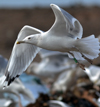 Larus cachinnans 4CY 455P October 28-30 2011, Deponie Pohlsche Heide - Minden, Germany (52°23'05N, 08°46'45E).
Picture: Armin Deutsch.
Larus cachinnans 4CY 455P October 28-30 2011, Deponie Pohlsche Heide - Minden, Germany (52°23'05N, 08°46'45E).
Picture: Armin Deutsch.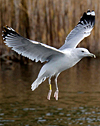 Larus cachinnans 1CY-4CY PKNX December 2012 - October 2015, France & Poland. Picture: Liliane Rogon, Patrick Fontaine, Janusz Wójcicki & Alain Fossé.
Larus cachinnans 1CY-4CY PKNX December 2012 - October 2015, France & Poland. Picture: Liliane Rogon, Patrick Fontaine, Janusz Wójcicki & Alain Fossé. Larus cachinnans sub-adult, October 26 2007, Westkapelle, the Netherlands. Picture: Ies Meulmeester.
Larus cachinnans sub-adult, October 26 2007, Westkapelle, the Netherlands. Picture: Ies Meulmeester. Larus cachinnans sub-adult, October 27 2013, Zagreb, Croatia (45°45'50"N 16°01'30"E). Picture Luka Jurinović.
Larus cachinnans sub-adult, October 27 2013, Zagreb, Croatia (45°45'50"N 16°01'30"E). Picture Luka Jurinović.  Larus cachinnans sub-adult, October 26 2007, Westkapelle, the Netherlands. Picture: Ies Meulmeester.
Larus cachinnans sub-adult, October 26 2007, Westkapelle, the Netherlands. Picture: Ies Meulmeester. Larus cachinnans sub-adult, October 23 2007, Maglebæk sø, Brøndby, Denmark. Picture: Lars Adler Krogh.
Larus cachinnans sub-adult, October 23 2007, Maglebæk sø, Brøndby, Denmark. Picture: Lars Adler Krogh. 